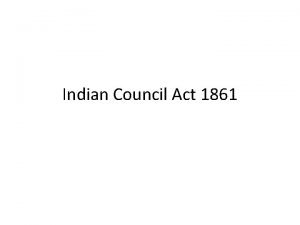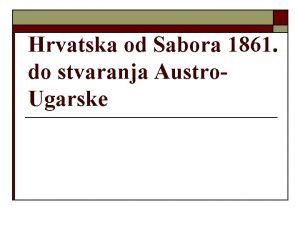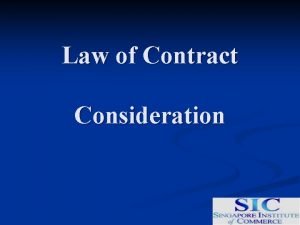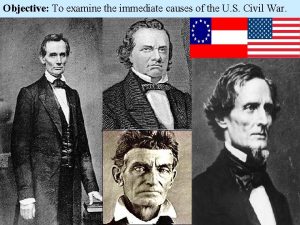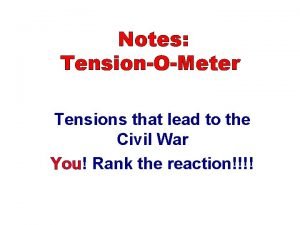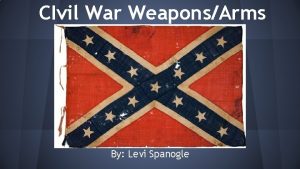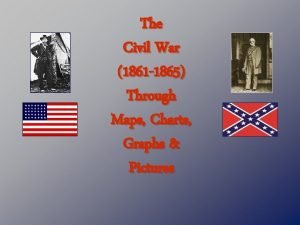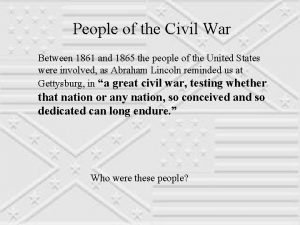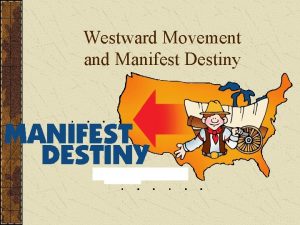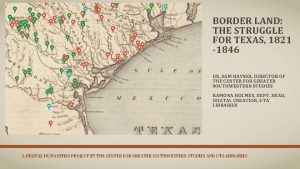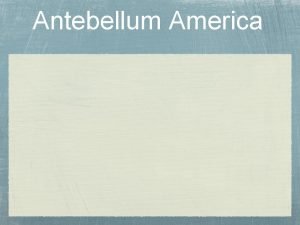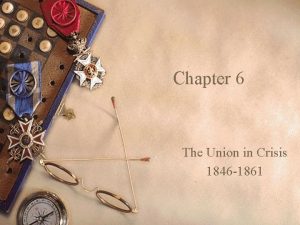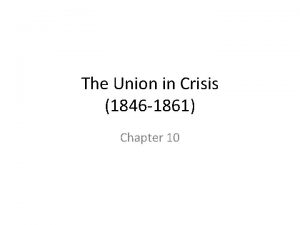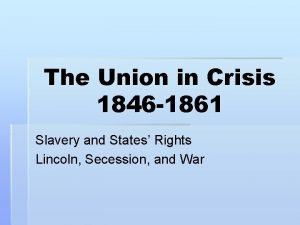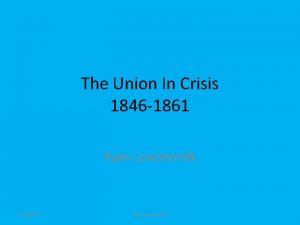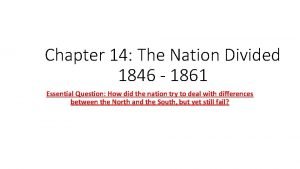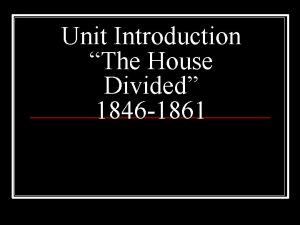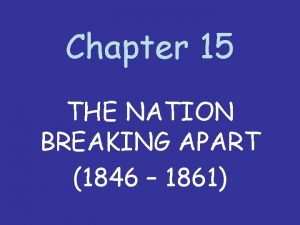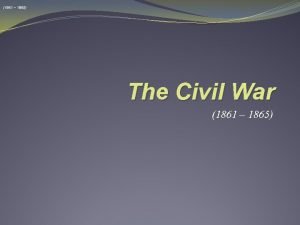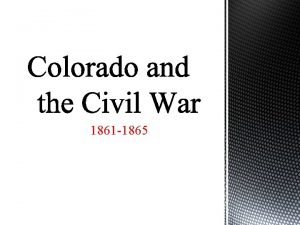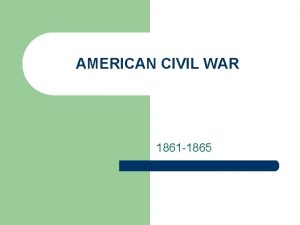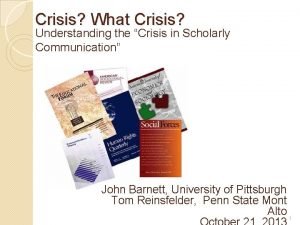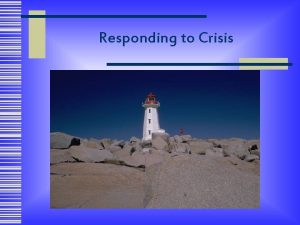Chapter 10 The Union in Crisis 1846 1861

























- Slides: 25

Chapter 10: The Union in Crisis 1846 -1861

Section 3 Political Realignment Deepens Crisis

American Political Parties ★Democratic Party (1800 to present) ○ Opposed strong Government ○ Divided over the issue of slavery ■ Southern Democrats--pro slavery ■ Other Democrats--popular sovereignty ★ Whig Party (1834 -1852) ○ Favored National Economic Development ○ Divided over slavery ■ Heavily favored Popular Sovereignty ■ Antislavery members left in 1850 --collapsed due to split

Democrats and Whigs

American Political Parties ★Know-Nothings/American Party (1843 -1856) ○ Anti-immigrant, anti-Catholic, believed that Catholics and immigrants would steal American jobs, undermine American religious freedom or be a “burden” on society ○ Anti slavery Whigs initially joined the party ○ 1856 will take a proslavery stance ★ Free Soil Party (1847 -1854) ○ Opposed expansion of slavery to Western Territories ○ Formed by Antislavery Whigs and Democrats ○ Absorbed by new Republican Party in 1854

Know-Nothings and Free Soilers

American Political Parties ★Republican Party (1854 -present) ○ ○ Opposed Slavery Opposed Kansas-Nebraska Act First abolition party despite antislavery sentiment growing Coalition of business leader as well as moral leaders

Election of 1856 ★Like 1848 would be a three way Presidential Race ★Unlike 1848, 1856 would highlight and further entrench regional differences North v. South ★Election would further divide and inflame the tension over slavery in US

Election of 1856 ★Candidates ○ Democratic Party ■ James Buchanan ● From Pennsylvania ○ PA had the second highest electoral votes with 27 ● Served in the House and the Senate for PA ● Promised to stop the agitation of the slavery issue

James Buchanan

Election of 1856 ★Candidates ○ Republican Party ■ John C. Fremont ● Explorer and veteran of the Mexican-American War in CA, eventually settling in CA ○ Previously a Senator of CA ■ Slogan: “Free soil, Free Labor, Free men, Fremont!” ■ Campaigned to admit Kansas as a free state

John C. Fremont

Election of 1856 ★Candidates ○ Know Nothings/ American Party ■ Millard Fillmore ● 13 th President of United States ● Last Whig President ● Left Presidency very unpopular

Millard Fillmore

Results of the Election

Dred Scott Decision ★1857 Supreme Court Case: Dred Scott v. Sandford ○ Dred Scott was a slave who sued for his freedom in court ■ His master moved to free state of Illinois and Wisconsin Territory and Scott believed he should have been freed due to the Missouri Compromise ■ With help of abolitionists his case made it to the Supreme Court ■ Chief Justice Roger B. Taney handed down the decision ● Taney was from a wealthy slave owning family in Maryland

Dred Scott Decision ★1857 Supreme Court Case: Dred Scott v. Sandford ○ Taney’s decision had two parts to it: ■ 1. Slaves were property, and could not sue in court ■ 2. The Missouri compromise was unconstitutional because Congress could not deprive a person of their property ○ ○ ○ Southerners celebrated the decision Northerners hated it--labeled it a Southern Conspiracy Pres. Buchanan fully endorsed it ■ Lobbied Taney to make the decision, called a doughboy Northerner with Southern sympathies

Dred Scott and Roger B. Taney

Lincoln-Douglas Debates ★A series of Debates for an Illinois Senate Seat in 1858 ★Stephen A. Douglas ○ A. k. a Little Giant ■ Short, round and full of energy ○ Sympathetic to slavery and backed popular sovereignty ■ Wife inherited slaves ○ Motives always questioned due to investment in railroads in western territories ○ “This Union was established on the right each State to do as it pleased on the question of slavery or any other question. ”

Stephen A. Douglas

Lincoln-Douglas Debates ★Abraham Lincoln ○ A. k. a “Honest Abe” ■ Built a reputation for integrity and directness ○ Seemed staunchly opposed to slavery, but most of his political career was trying to find a middle ground ○ In 1854, staunchly opposed the Kansas-Nebraska Act and the expansion of slavery ○ Chief rival of Stephen A Douglas ★ Douglas would win the seat but only by a slim margin ★ Lincoln was able to build a national following, which would help next time he ran for national office

Abraham Lincoln

John Brown’s Raid and Execution ★ Stephen Douglas and Abraham Lincoln felt that slavery needed to be solved within the nation’s laws ★ John Brown, however felt no ruch restrictions ○ John Brown viewed himself as an angel of God out to avenge slavery, even before Bleeding Kansas ○ Brown lost a son in Bleeding Kansas and it only strengthened his fanaticism ○ In Brown’s point of view violence was the only solution ★ Fall of 1859, John Brown set his sight on the federal arsenal at Harpers Ferry, Virginia (now West Virginia)

John Brown’s Raid and Execution ★ John Brown and his following of 21 men (which included his sons), attacked Harpers Ferry hoping to inspire nearby slaves and abolitionists to join the fight. ○ No one joined ○ Federal troops lead by Robert E. Lee surrounded the arsenal and arrested John Brown and a few of his followers ■ 2 more of John Brown’s sons were killed during the fray ★ John Brown was executed, he was viewed differently by many ○ Southerners increased temperature and suspicions ○ Northerners: some saw it as too far, others saw him as a martyr

Credits ★ Background: John Doherty, https: //edex. adobe. com/resource/b 0578 ce 8 ★ Images: Google Image Search ★ Animations: animationfactory. com
 Indian councils act 1861
Indian councils act 1861 Unionistička stranka 1861
Unionistička stranka 1861 England v davidson (1840)
England v davidson (1840) John brown poster
John brown poster Tensionometer
Tensionometer Springfield model 1861 rifle facts
Springfield model 1861 rifle facts Civil war 1861/1862
Civil war 1861/1862 Civil war 1861/1862
Civil war 1861/1862 Myasthenic crisis vs cholinergic crisis
Myasthenic crisis vs cholinergic crisis Intersect and minus in sql
Intersect and minus in sql The oregon treaty of 1846
The oregon treaty of 1846 Guilty poem
Guilty poem Din 1846-2
Din 1846-2 Din en 1846
Din en 1846 1846
1846 In 1846 congressman david wilmot proposed to
In 1846 congressman david wilmot proposed to Hát kết hợp bộ gõ cơ thể
Hát kết hợp bộ gõ cơ thể Ng-html
Ng-html Bổ thể
Bổ thể Tỉ lệ cơ thể trẻ em
Tỉ lệ cơ thể trẻ em Voi kéo gỗ như thế nào
Voi kéo gỗ như thế nào Glasgow thang điểm
Glasgow thang điểm Bài hát chúa yêu trần thế alleluia
Bài hát chúa yêu trần thế alleluia Môn thể thao bắt đầu bằng từ đua
Môn thể thao bắt đầu bằng từ đua Thế nào là hệ số cao nhất
Thế nào là hệ số cao nhất Các châu lục và đại dương trên thế giới
Các châu lục và đại dương trên thế giới
